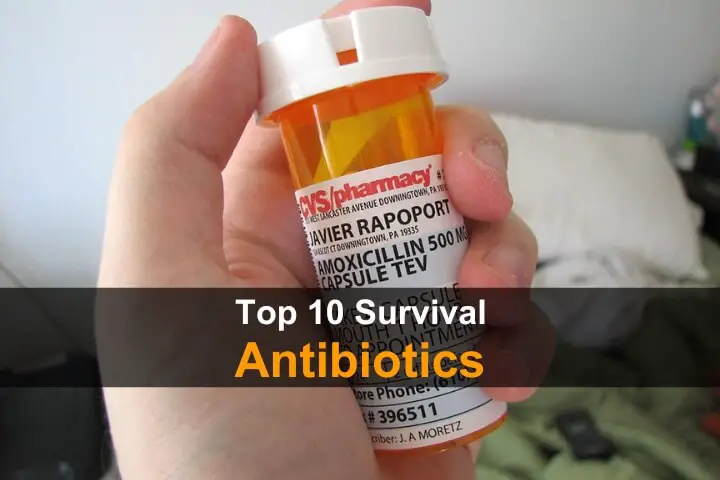Estimated reading time: 10 minutes
Survival antibiotics are often overlooked by preppers, and that’s a shame because they’re important. Really, really important. Many people don’t realize this, but antibiotics save millions of lives every single year. Before antibiotics were developed, even a small cut or wound could be a death sentence. One little infection and bam!—game over.
And that’s exactly why every prepper should learn the basics of antibiotics and figure out a way to stock up on then in case of a long-term disaster. What if you’re in a scenario where the pharmacies are empty or closed and a family member gets a serious infection? What would you do?
Want to save this post for later? Click Here to Pin It On Pinterest!
I’ve thought about that a lot ever since antibiotics saved my life. About 10 years ago, on an ordinary evening after dinner, my stomach started bothering me. It wasn’t nausea or a normal stomach cramp. It was a strange gnawing pain I’d never felt before. I tried antacids and Pepto Bismol, but nothing worked. I finally took some Tylenol and went to bed.
The next day, the pain was still there, but it had moved to my lower right abdomen. As the day continued, it got worse. And worse. Pretty soon, it was so bad that I decided to go online and do some research. I thought it might be a torn muscle or my appendix, but those things didn’t really fit the symptoms.
That evening, the pain was so bad that I could barely move. I had to walk hunched over and take tiny steps. Any sudden movement caused excruciating pain. It was so bad that my wife had to help me take my shirt off before bed. The next morning, it hadn’t gotten any better, so she took me to urgent care.
It was a long day. The doctor asked a lot of questions and felt my abdomen, but he wasn’t sure what it could be, so he ordered blood work and a CAT scan. He thought it might be my gall bladder, which would mean emergency surgery. But again, he wasn’t sure because the symptoms didn’t make sense.
Of course, my wife and I were both afraid it could be something life-threatening. Eventually, a radiologist took a look at the scans and found the problem: I had some type of infectious colitis in my ascending colon. Basically, my colon was severely inflamed by a bacterial infection.
The doctor said he’d never seen anything like it. His best guess was that I got it from eating some undercooked meat, which made sense because I had recently eaten a hastily-cooked hamburger.
This infection was so bad, it would have killed me if not for the medication he prescribed. And what was this miraculous, life-saving medication? You guessed it: antibiotics. Specifically, Ciprofloxacin and Metronidazole. After 10 days of taking those, I was good as new. If not for antibiotics, my wife would have become a widow just a few years after we got married, and my children wouldn’t even exist.
I tell this story so you’ll understand how important antibiotics are. Even if you’re very careful, you could still get a deadly infection. But before we move on, remember that I am not a doctor and I’m not giving you medical advice. I’m just sharing information I learned. You should talk to your doctor and do your own research before taking or stockpiling antibiotics.
There are many types of antibiotics, but I’ve narrowed it down to what I think are the 10 most important. These should cover almost 99{ebf8267f808eac43d24742043db51eeeb004db6334271e1bb6fe8c21c7925753} of infections. You don’t need to get every single one on this list (for example, Cephalexin, Amoxicillin, and Erythromycin are all very similar, but you might have trouble finding a couple of them).
I can’t tell you everything you need to know in one post, so I’d suggest getting a copy of Alton’s Antibiotics and Infectious Disease: The Layman’s Guide to Available Antibacterials in Austere Settings. This book will tell you everything you need to know about antibiotics and antifungals in emergency scenarios.
All right, let’s get to my list of the top 10 survival antibiotics.
Top 10 Survival Antibiotics
1. Amoxicillin
Amoxicillin is number one on this list because it’s effective against a wide range of infections including ear infections, sinusitis, and pneumonia. Plus, most people don’t feel any side effects. It’s also safe for pregnant women, children, and nursing mothers.
2. Azitrhomycin
Azitrhomycin is similar to Cephalexin, Amoxicillin, and Erythromycin because it treats respiratory infections and all sorts of things like Chlamydia, Lyme Disease, PID, Syphilis, Typhoid, etc. Side effects include abdominal pain, nausea, and diarrhea, but that is rare.
It’s a great antibiotic to have because it treats so many different things. The problem is that it’s hard to find and can be a bit expensive.
3. Cephalexin
Cephalexin is great for almost any type of respiratory infection (bronchitis, pneumonia, strep throat, etc.) and middle ear infections. It’s safe for pregnant women and children and only has a few potential side effects such as nausea or diarrhea.
4. Penicillin
Penicillin is essential for treating a variety of bacterial infections such as strep throat, pneumonia, syphilis, and skin infections. It’s one of the safest antibiotics, making it ideal for families with children and pregnant women. However, penicillin allergies are very common, so make sure you’re aware of everyone’s allergies before you use it.
5. Doxycycline
Doxycycline treats the same types of infections as Erythromycin. It can also treat sinus infections, Typhus, and Malaria. However, it should not be used by children, pregnant women, or nursing mothers, and there are some side effects, including kidney impairment and sensitive skin.
6. SMZ-TMP
That is short for Sulfamethoxazole and Trimethoprim. Together, these can treat most respiratory infections, but they’re mainly used for urinary tract infections. The best thing about SMZ-TMP is it can treat MRSA (Methicillin-resistant Staphylococcus aureus), also known as resistant staph. This is a strain of bacteria that spreads easily and is resistant to most antibiotics.
However, these aren’t recommended for people with kidney or liver disease, or for those who have severe allergies or asthma, unless you have no other alternatives.
7. Metronidazole
Metronidazole is usually used for getting rid of anaerobic bacteria which is found in the intestine. It can treat diverticulitis or colitis if you take it with Ciprofloxacin, and it can also treat bacterial vaginosis, diabetic foot ulcer, joint or bone infections, lung or brain abscesses, meningitis, and a few other infections.
This also shouldn’t be taken by children or nursing mothers. It shouldn’t be taken by pregnant women either unless the benefits outweigh the risks, for example in the treatment of bacterial vaginosis to reduce the risk of preterm birth.
8. Ciprofloxacin
Ciprofloxacin is best for things like urinary tract infections, prostate infections, respiratory tract infections (such as bronchitis or pneumonia), bacterial diarrhea, anthrax, and diverticulitis or infectious colitis (when combined with Metronidazole).
It should never be used by pregnant women or nursing mothers. Children shouldn’t take it either except for extreme scenarios like anthrax exposure or complicated urinary tract infections.
9. Erythromycin
Like amoxicillin and cephalexin, this one can also treat most respiratory infections and middle ear infections. It’s also good for Syphilis, Lyme Disease, and Chlamydia. And it’s safe for women, children, and nursing mothers.
Unfortunately, it has several potential side effects including abdominal pain, nausea, vomiting, and diarrhea. If it’s the only antibiotic you can find, go for it, but there are plenty of alternatives.
10. Ampicillin
Ampicillin is similar to penicillin, but it’s more effective against things like anthrax and less likely to cause an allergic reaction. It’s also useful for respiratory tract infections, bacterial meningitis, urinary tract infections, gastrointestinal infections, and many other things.
Which Antibiotics Should You Stockpile?
If you don’t want to stockpile all 10 of these, then try to store at least 3 of them. However, you don’t necessarily want to get the first 3 on the list. Rather, you want to cover as wide a range of bacterial infections as possible, so I recommend this combination:
- Amoxicillin: Good for a wide range of infections including respiratory, ear, and sinus infections.
- Azithromycin: Effective against a variety of bacterial infections, especially respiratory tract infections and sexually transmitted diseases. Also, you only need to take one a day for five days.
- SMZ-TMP (Sulfamethoxazole and Trimethoprim): This combination covers a different set of pathogens, including MRSA and some types of pneumonia and urinary tract infections.
All three of these are generally safe for children and pregnant women, except for SMZ-TMP, which is fine for children except those under 3 months, and only recommended for pregnant women who are in their second trimester.
Where to Get Antibiotics
Your Doctor – The first thing you could do is ask your doctor. Tell him or her that you want to stockpile some basic antibiotics in case of a long-term disaster or emergency of some kind. They might think you’re crazy, and they might say no, but it can’t hurt to ask.
Jase Medical – This website sells all sorts of medications you might need in an emergency, including antibiotics. They sell an emergency case that includes Amoxicillin, Azithromycin, Ciprofloxacin, Doxycycline, and Metronidazole.
Veterinary Antibiotics – People often use antibiotics to keep bird cages and aquariums disease free, but they go by different terms:
- Bird Sulfa = SMZ-TMP
- Fish Cillin = Ampicillin
- Fish Cycline = Doxycycline
- Fish Flex = Cephalexin
- Fish Flox = Ciprofloxacin
- Fish Mox = Amoxicillin
- Fish Zole = Metronidazole
Many preppers stockpile these instead of traditional antibiotics. However, the ones sold for bird cages and aquariums are not designed for human consumption, so take them at your own risk.
Plus, you would need to adjust the dosage based on whoever is taking it, so I would only go this route if you know what you’re doing or have a doctor or expert with you.
How to Store Antibiotics
Liquid antibiotics usually need to be refrigerated, as do some antibiotic pills, so be sure to read the label. However, most of the pills can be kept at room temperature or below for a long time.
Like most medications, you want to keep your antibiotics in the original package in a cool, dark, dry location. If possible, put the package in an airtight container. If you do this, most antibiotics will last several years past their expiration date, after which their effectiveness will fade over time.
However, certain antibiotics, such as tetracycline, can become toxic or even deadly after their expiration date. It just depends. This is why you need a good book or expert to guide you.
Be sure you regularly check your antibiotics for signs of degradation such as changes in color, smell, or texture. Also, do not freeze antibiotics. Doing so will alter their chemical makeup and make them useless.
Other Tips and Warnings
Before you use antibiotics, make sure you know whether you or anyone in your family or group has any allergies to antibiotics. If you aren’t sure, I would find a clinic that does allergy testing. They’ll also warn you of any other types of allergies you might have. This information could be lifesaving.
If you take antibiotics and develop a rash or any other reactions, stop taking them immediately. If there’s no reaction and your condition improves, continue taking them for the prescribed time (usually 10-14 days), even if you feel better.
Don’t take antibiotics any time you have a pain or a fever. You should only use them if you know exactly what you’re treating. The overuse of antibiotics around the world has caused many of them to become less effective thanks to bacteria that have evolved to overcome antibiotics, but that’s a whole other topic.
And that’s it! Again, make sure you do your homework or consult a doctor before stockpiling or using antibiotics. Maybe someday they will save your life just like they saved mine.
Like this post? Don’t Forget to Pin It On Pinterest!
You May Also Like:




